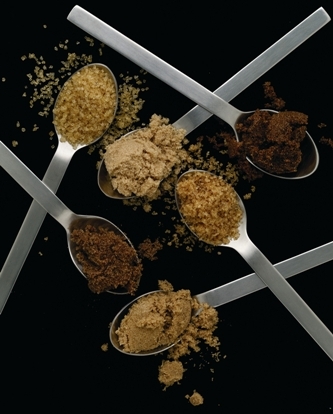
Virgil Evetts
Cane sugar is one of the most widely used ingredients in our pantries today. Its popularity and use is pan-cultural and it ranks as one of the most important tradable commodities on the planet. We stir it into our tea and coffee, add to it cakes, curries, jams and juices day every day, but how much do we really know about sugar? Is there any difference between cheap, refined sugars and their pricier counterparts? Is brown sugar the same thing as Demerara, when should we use Muscovado, and just what is Molasses sugar? Read on for all these answers and more, plus some first-rate recipes kindly supplied by Billington’s- makers of some of the finest sugars I’ve ever encountered. Seriously.
Humans, like most primates, are born with a sweet tooth (or maybe teeth). This is because sugary foods offer fast bursts of easy-access energy. They really do hit the spot. In the distant prehistoric past when just surviving from sunrise to sunset took a marathon effort, any amount of sugar – in the form of fruit and the odd bit of raided honey – could be safely ingested without fear going plus sized. Nowadays with our relatively laid-back lives, such foods are best eaten with a modicum of restraint because our bodies have a natural piggy-bank attitude to unspent energy, laying any excess down as fat. So it’s not just greed that makes you linger in the confectionary aisle, it’s a biological imperative!
Today, about 70% of the worlds is produced from sugar cane (Saccharum. s), a family of tall tropical grass with naturally high levels of sugar (about 10%). The bamboo-like stems of the sugar cane are pulped and pressed to extract their sweet juice, which is then boiled until the water has evaporated and the sugar content begins to crystallise. This crystalline slurry is then spun in a centrifuge to remove excess liquid. The resulting raw sugar can then further processed into any number of different types and grades of sugar, from moist and liquoricey molasses sugar, to the free-flow and flavourless refined white sugar. Sugar cane plants grow well in northern New Zealand and although making your own sugar is a bit too involved for most, with the aid of an old washing machine mangle you can produce delicious sugar cane juice. This is a very popular and refreshing drink sold by street vendors throughout tropical Asia.
Incidentally, the remaining 30% of the world’s sugar is made from the sugar beet – a turnip-like vegetable traditionally grown where sugar cane wouldn’t survive – including parts of Russia nudging the Arctic Circle.
The variety of sugars available in even the most humble supermarket today can be quite bewildering. Things are further complicated by inconsistencies in the names for sugar types between countries and between food writers e.g. brown sugar can be called Demerara, soft brown, Muscovado etc depending on the inclination and knowledge of the writer. So here goes – your quick guide to the very best sugars.
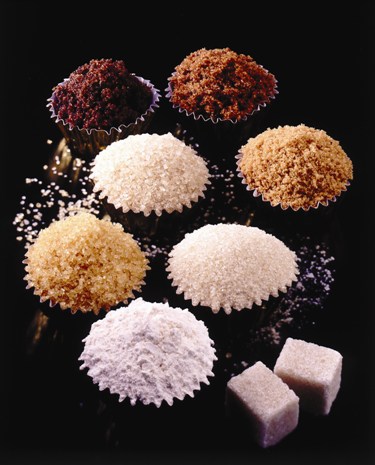
The Billington’s Natural Sugar range. Clockwise from front right: Cubes, Golden Icing Sugar, Natural Demerara Sugar, Golden Granulated Cane Sugar, Natural Molasses Sugar, Natural Dark Muscovado Sugar, Natural Light Muscovado Sugar, Golden Caster Sugar.
Refined White Sugar/ Caster Sugar/Icing sugar
This tends to be the workhorse sugar in most kitchens, and while it packs plenty of sweetness it lacks much in the flavour department. As the name suggests, refined sugar has been purified and scrubbed clean of everything other than sucrose; this means no molasses (a dark, sweet by-product of the sugar evaporation process), no other organic compounds, nada. To achieve this level of purity the raw sugar is bleached with carbon dioxide and/or lime before being filtered through beef-bone char.
Caster sugar and icing sugar are grades of crystal size rather than actual types of sugar, but are most often made from refined white sugar. Icing sugar often contains an anti-caking agent too.
Billington’s Natural Golden Granulated Cane Sugar
This is essentially the original raw sugar, crystallised from cane juice and then cleaned of any undesirables (such as plant fibres and dirt), but still containing traces of molasses, which imparts a golden hue to the crystals. Like refined white sugar this is a free-flow product, but has a delicate yet unobtrusive hint of caramel to its flavour profile. Natural Golden Granulated Cane Sugar is great in a cup of tea and is an excellent alternative to refined sugar in baking – as in this rather good Pear and Cinnamon Upside-down Cake and wherever else a caramel accent is needed- like this Balsamic Glazed Chicken with Spring Onion Mash
NB Billington’s also produce an Organic version of this product
Billington’s Natural Demerara Sugar (often known as ‘raw sugar’ in New Zealand),
In the manufacturing of Demerara sugar a relatively high percentage of molasses is allowed to remain, producing a very golden crystal with a rich caramel flavour. Many inferior brands add molasses back into refined sugar to produce this and many other types of brown sugar. This practice has a detrimental effect on flavour. Demerara sugar has a larger crystal size than most other sugars and is perfectly suited to spooning into coffee. The crunchy texture and warm, rounded flavour of Demerara works very well in and on biscuits and crumbles. Try this excellent Fruit Crumble recipe if you’re in need of a little Demerara inspiration NB ‘Coffee crystal/sugar’ is simply Demerara sugar with super-sized crystals.
Billington’s Natural Light Muscovado Sugar
This is what most of us in New Zealand call soft brown sugar. It’s a fine-grained sugar with a naturally high moisture content. Light Muscovado is the ultimate breakfast sugar – sprinkle it over porridge, cereal or grapefruit and use it to make the finest cinnamon toast. With its molasses-inflected flavour, Light Muscovado Sugar is also the natural choice for caramel-themed desserts, like these gorgeous Caramel Meringues with Seasonal Fruit . For a savoury option try this sticky, succulent Sizzling Salmon with Steamed Pak Choi
Billington’s Natural Dark Muscovado Sugar
A sugar for those who love brown sugar but have always wanted more, Dark Muscovado has an even higher molasses content than it its lighter counterpart and an accordingly richer, deeper flavour. Dark Muscovado is without peer when it comes to making Christmas cakes, puddings and mince pies, and is the sugar of choice for many a home chutney and relish maker. And if that’s not inspiration enough, try these Banana and Muscovado Muffins
Billington’s Natural Molasses Sugar
A true connoisseur’s sugar, this supersized cousin of Muscovado has the highest molasses content of any sugar and a potent, almost liquoricey flavour. Although it can be used wherever Muscovado or soft brown sugar is called for, the following 2 recipes do a good job of showcasing the many charms of Natural Molasses Sugar
So as you can see, sugar is not just sugar. It is a varied and nuanced product that is too often taken for granted. I was as guilty of this as the next person but having now sample d the entire Billington’s range of natural sugars- I will never look at sugar the same way again.
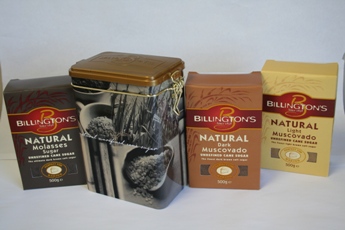
Click here to go into the draw to win a deluxe box of Billington’s Natural Sugars .


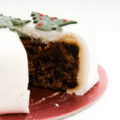
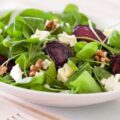
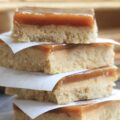
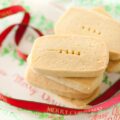
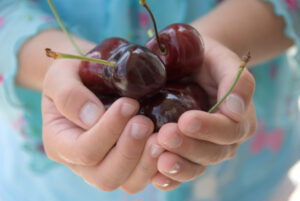
Can I have your brown sugar recipe please?
Hi, I am succsessfully growing a lot of sugar cane on Waiheke Island, do you have a contact where i could buy a sugar cane jucier for home use.
Thanks
Andrew
I wish I did Andrew! Apparently you can run the canes through a garden shredder and then press through an old washing machine mangle. If you were really serious you could import a sugar cane press from South East Asia. Not cheap though….
I am half way through my first ever box of Billington’s Dark Muskovado Sugar. It is truely divine. With Malaysian Whole fish, with apple sauce. With anythng. The molasses flavour is intense and dliscious.
Bring me more. I’m about to try some recipes from your web site…..
x
In your v informative article on sugars you did not mention the delightful multi coloured sugar crystals that I have not seen for ages – I have vivid memories if two very old aunts serving tea with a crystal bowl of mult coloured sugar crystals that used to catch the late afternoon light and as a child I was allowed one teaspoon as a special treat – are they still available I wonder?
Im horrified at how much sugar is in our diet. In our natural state to consume that much sugar our natural habitat would surely have to be a sugar cane plantation.
Someone told me you try and keep sugar out of your home.. It’s almost impossible. Even a can a salad beans has sugar in it.
I heard somewhere that if sugar was introduced today that under current regulations it would be classified as a drug… if that is so I guess that makes us all druggies.
Finding recipes without sugar is hard too.
Hmmm – wonder if there are any on this site.
Although they’re in the pictures, you didn’t mention the golden icing sugar and caster sugar. I’ve been waiting impatiently for these to get to NZ: according to Nigella, the golden icing sugar is an easy way to give a caramelly flavour to icing. Can’t wait to try it.